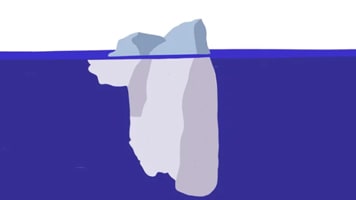A symptom may only be the tip of the iceberg – with a much bigger problem lying under the surface. A symptom is just a symptom – it isn’t the cause. Symptoms are a bit like the fire alarm going off, to warn you that there is a problem. The fire alarm is not the problem, the fire is!
It is also important to understand that symptoms may be due to dysfunction in a part of the spine that seems unrelated to the problem area
Spinal Movement
For example, you have pain in your left knee. It’s hard to imagine that this pain could have anything to do with your spine. But, if your spine is not moving properly, it may interrupt the flow of information from your leg to your brain and back again. Poor movement sustained over time often creates an imbalance in your body and may cause pain.
Subtitle languages available
Video Transcript
If you are visiting your chiropractor today because you have a symptom, such as pain, it is important to understand that troublesome symptoms don’t appear out of thin air.
They build up over time like the analogy of straws on a camel’s back. Hundreds of straws are stacked up over time, yet with the addition of the thousandth tiny straw, the camel’s back suddenly breaks. It’s the same with symptoms – the problem can build up unnoticed over time, then suddenly symptoms make themselves known in a big way.
A symptom may only be the tip of the iceberg – with a much bigger problem lying under the surface1. After all, a symptom is just a symptom – it isn’t the cause.
Symptoms are a bit like the fire alarm going off, to warn you that there is a problem. The fire alarm is not the problem, the fire is! So don’t turn the fire alarm off and ignore the problem, go find the cause and put out the fire.
For a chiropractor to help you, it may take a number of visits. If your problem took time to build up to the level it is at today, more often than not it will take time to resolve it too2 3.
It is also important to understand that symptoms may be due to dysfunction in a part of the spine that seems unrelated to the problem area 1 4.
Here’s an example. It may be that you have pain in your left knee. It’s hard to imagine that this pain could have anything to do with your spine. But, if your spine is not moving properly, it may be interrupting the flow of information from your leg to your brain and back again5 6. And because of this, your leg may be receiving faulty messages from your brain, which means your knee moves in a less than ideal way. Poor movement sustained over time often creates an imbalance in your body and may cause pain.
Remember that your body is one big interconnected system – no part of it operates in isolation.
The objective of chiropractic care is to restore healthy communication throughout your body, and to maintain this communication over time, leading to better function, less accidents and a healthier you!
References
- Complaint of Knee Pain. The Journal of Spinal Cord Medicine 2010;33(4):431-34. doi: 10.1080/10790268.2010.11689724
- Haas M, Spegman A, Peterson D, et al. Dose response and efficacy of spinal manipulation for chronic cervicogenic headache: a pilot randomized controlled trial. The spine journal 2010;10(2):117-28.
- Haas M, Vavrek D, Peterson D, et al. Dose-response and efficacy of spinal manipulation for care of chronic low back pain: a randomized controlled trial. The Spine Journal 2014;14(7):1106-16.
- Buckland AJ, Miyamoto R, Patel RD, et al. Differentiating hip pathology from lumbar spine pathology: key points of evaluation and management. JAAOS-Journal of the American Academy of Orthopaedic Surgeons 2017;25(2):e23-e34.
- Haavik H, Murphy B. The role of spinal manipulation in addressing disordered sensorimotor integration and altered motor control. Journal of Electromyography and Kinesiology 2012;22(5):768-76.
- Holt KR, Haavik H, Lee ACL, et al. Effectiveness of Chiropractic Care to Improve Sensorimotor Function Associated With Falls Risk in Older People: A Randomized Controlled Trial. Journal of Manipulative and Physiological Therapeutics 2016;39(4):267-78. doi: 10.1016/j.jmpt.2016.02.003

